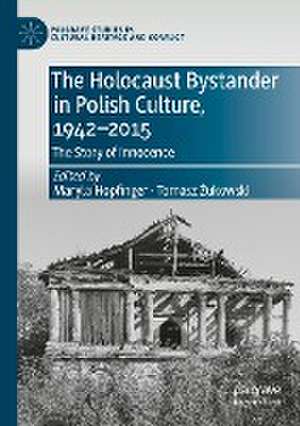The Holocaust Bystander in Polish Culture, 1942-2015: The Story of Innocence: Palgrave Studies in Cultural Heritage and Conflict
Editat de Maryla Hopfinger, Tomasz Żukowskien Limba Engleză Paperback – 19 mar 2022
| Toate formatele și edițiile | Preț | Express |
|---|---|---|
| Paperback (1) | 784.13 lei 6-8 săpt. | |
| Springer International Publishing – 19 mar 2022 | 784.13 lei 6-8 săpt. | |
| Hardback (1) | 787.78 lei 6-8 săpt. | |
| Springer International Publishing – 17 mar 2021 | 787.78 lei 6-8 săpt. |
Din seria Palgrave Studies in Cultural Heritage and Conflict
- 20%
 Preț: 568.11 lei
Preț: 568.11 lei - 15%
 Preț: 696.68 lei
Preț: 696.68 lei -
 Preț: 415.77 lei
Preț: 415.77 lei - 18%
 Preț: 780.19 lei
Preț: 780.19 lei - 15%
 Preț: 589.33 lei
Preț: 589.33 lei - 18%
 Preț: 737.57 lei
Preț: 737.57 lei - 15%
 Preț: 594.24 lei
Preț: 594.24 lei - 18%
 Preț: 786.84 lei
Preț: 786.84 lei - 18%
 Preț: 949.42 lei
Preț: 949.42 lei - 18%
 Preț: 733.03 lei
Preț: 733.03 lei - 18%
 Preț: 901.11 lei
Preț: 901.11 lei - 18%
 Preț: 792.34 lei
Preț: 792.34 lei - 20%
 Preț: 767.40 lei
Preț: 767.40 lei - 15%
 Preț: 588.18 lei
Preț: 588.18 lei -
 Preț: 233.58 lei
Preț: 233.58 lei - 18%
 Preț: 726.06 lei
Preț: 726.06 lei -
 Preț: 380.45 lei
Preț: 380.45 lei -
 Preț: 386.39 lei
Preț: 386.39 lei - 18%
 Preț: 777.69 lei
Preț: 777.69 lei - 18%
 Preț: 894.79 lei
Preț: 894.79 lei - 18%
 Preț: 725.13 lei
Preț: 725.13 lei -
 Preț: 484.47 lei
Preț: 484.47 lei -
 Preț: 385.84 lei
Preț: 385.84 lei - 15%
 Preț: 640.71 lei
Preț: 640.71 lei - 18%
 Preț: 730.97 lei
Preț: 730.97 lei -
 Preț: 390.25 lei
Preț: 390.25 lei -
 Preț: 388.13 lei
Preț: 388.13 lei -
 Preț: 385.84 lei
Preț: 385.84 lei
Preț: 784.13 lei
Preț vechi: 956.26 lei
-18% Nou
Puncte Express: 1176
Preț estimativ în valută:
150.04€ • 163.49$ • 126.43£
150.04€ • 163.49$ • 126.43£
Carte tipărită la comandă
Livrare economică 23 aprilie-07 mai
Preluare comenzi: 021 569.72.76
Specificații
ISBN-13: 9783030664107
ISBN-10: 3030664104
Ilustrații: XVII, 364 p. 39 illus.
Dimensiuni: 148 x 210 mm
Greutate: 0.5 kg
Ediția:1st ed. 2021
Editura: Springer International Publishing
Colecția Palgrave Macmillan
Seria Palgrave Studies in Cultural Heritage and Conflict
Locul publicării:Cham, Switzerland
ISBN-10: 3030664104
Ilustrații: XVII, 364 p. 39 illus.
Dimensiuni: 148 x 210 mm
Greutate: 0.5 kg
Ediția:1st ed. 2021
Editura: Springer International Publishing
Colecția Palgrave Macmillan
Seria Palgrave Studies in Cultural Heritage and Conflict
Locul publicării:Cham, Switzerland
Cuprins
1. Chapter 1: We are all witnesses. Instead of an introduction; Maryla Hopfinger.- 2. Chapter 2: Constructing the Figure of the Polish Shoah Witness; Katarzyna Chmielewska.- 3. Chapter 3: Alternative Narratives of the 1940s vs. the Politics of Memory; Katarzyna Chmielewska.- 4. Chapter 4: Hand in hand. Calling on witnesses to Polish-Jewish brotherhood; Anna Zawadzka.- 5. Chapter 5: Bearing witness to witnessing: Jewish narratives about Polish “witnesses” to the Holocaust; Anna Zawadzka.- 6. Chapter 6: The guilt of indifference; Aránzazu Calderón Puerta, Tomasz Żukowski.- 7. Chapter 7: Nostalgic archeology and critical archeology; Tomasz Żukowski.- 8. Chapter 8: Documents and fictions; Wojciech Wilczyk.-
Notă biografică
Maryla Hopfinger is Professor Emeritus at the Institute of Literary Research at the Polish Academy of Sciences, Poland. She works in the areas of the theory of culture and social communication. She has authored numerous books and articles and has also acted as editor to a number of collected volumes. Her most recent publication in English (2010, translated in 2020) is entitled Literature and Media.
Tomasz Żukowski is Assistant Professor at the Institute of Literary Research at the Polish Academy of Sciences, Poland. He is a literary historian interested in the identity and discourses in the context of the Shoah. Previous works include The Great Whitewash (2018) and Under Pressure.(2021).
Tomasz Żukowski is Assistant Professor at the Institute of Literary Research at the Polish Academy of Sciences, Poland. He is a literary historian interested in the identity and discourses in the context of the Shoah. Previous works include The Great Whitewash (2018) and Under Pressure.(2021).
Textul de pe ultima copertă
This book concerns building an idealized image of the society in which the Holocaust occurred. It inspects the category of the bystander (in Polish culture closely related to the witness), since the war recognized as the axis of self-presentation and majority politics of memory. The category is of performative character since it defines the roles of event participants, assumes passivity of the non-Jewish environment, and alienates the exterminated, thus making it impossible to speak about the bystanders’ violence at the border between the ghetto and the ‘Aryan’ side. Bystanders were neither passive nor distanced; rather, they participated and played important roles in Nazi plans. Starting with the war, the authors analyze the functions of this category in the Polish discourse of memory through following its changing forms and showing links with social practices organizing the collective memory. Despite being often critiqued, this point of dispute about Polish memory rarely belongs to mainstream culture. It also blocks the memory of Polish violence against Jews. The book is intended for students and researchers interested in memory studies, the history of the Holocaust, the memory of genocide, and the war and postwar cultures of Poland and Eastern Europe.
Caracteristici
Explores how the category of “indifferent bystander” functioned in Polish culture between 1942 and 2015 Analyses the discourse in this area, revealing how the category of “indifferent bystander” establishes the framework of talking and thinking about the Holocaust in Poland Contributors are participants and specialists of the culture discussed, leading to a critical analysis of the culture in which they partake
